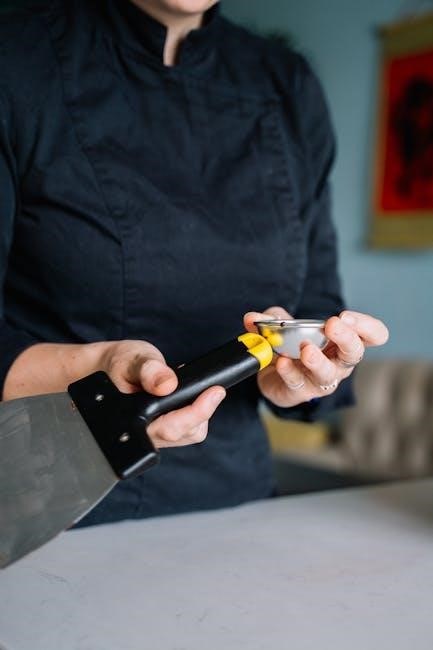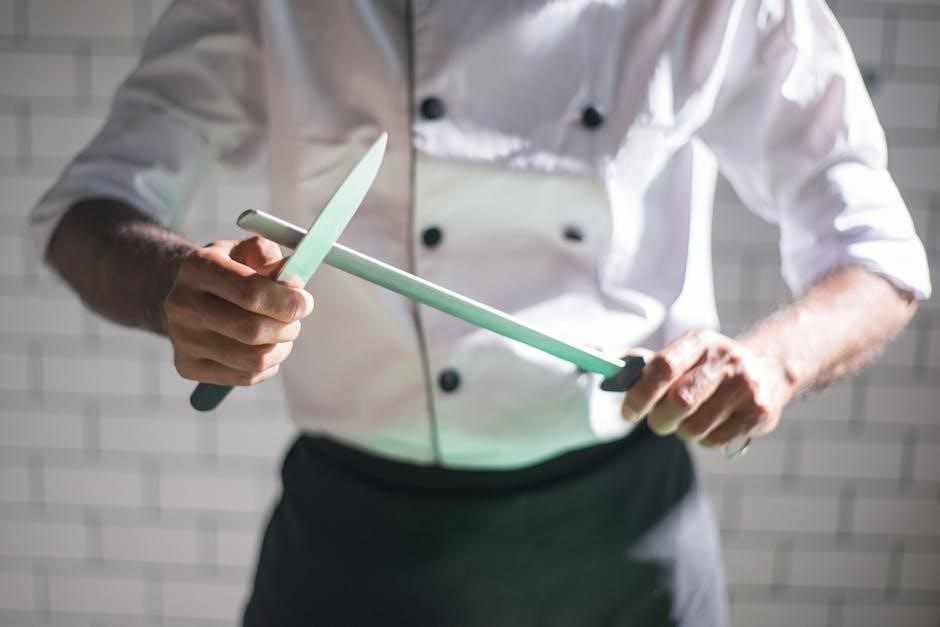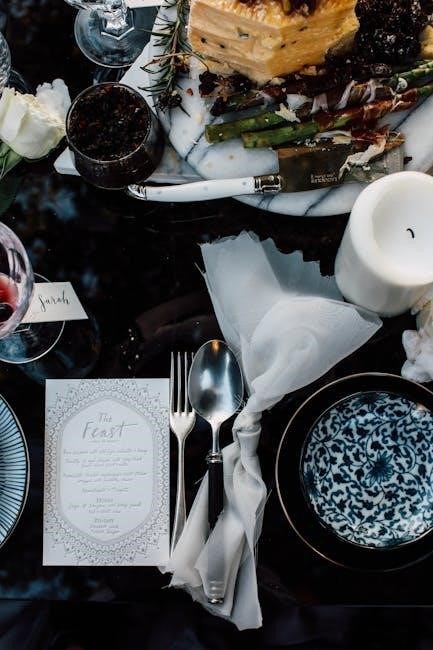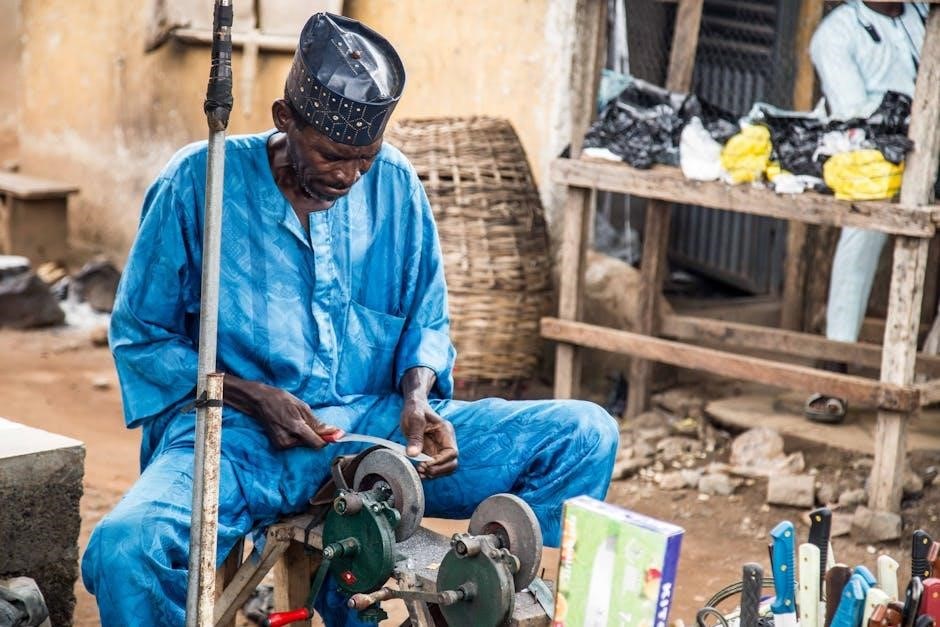Proper knife angle sharpening is crucial for maintaining sharpness and extending blade longevity. Consistent angles ensure precise cutting performance, while tools like guides help achieve optimal results.
1.1 Importance of Proper Sharpening Angles
Proper sharpening angles are essential for maintaining a knife’s sharpness and longevity. Incorrect angles can lead to a dull edge or uneven bevels, reducing the blade’s performance and durability. Precision in angle control ensures consistent results, preventing damage and optimizing cutting efficiency. Tools like angle guides and honing jigs help achieve the desired geometry for precise sharpening.
1.2 Overview of Knife Sharpening Basics
Knife sharpening involves creating a precise edge by removing metal through controlled abrasion. It requires understanding angles, using sharpening stones, and maintaining consistency. Tools like angle guides and honing steels aid in achieving the desired edge geometry. Proper technique ensures sharpness, durability, and optimal performance, making it a fundamental skill for knife maintenance and use.
Understanding Knife Sharpening Angles
Understanding sharpening angles is fundamental for achieving a sharp, durable edge. Different knives require specific angles, ranging from 10 to 30 degrees, depending on their intended use.
2.1 Common Sharpening Angles for Different Knives
Knife sharpening angles vary based on the knife’s purpose. Kitchen knives typically use 15-20 degrees, while Japanese knives often require a finer 10-15 degrees. Hunting knives may need a sturdier 20-30 degrees; Adjustable angle guides help maintain consistency across different blade types, ensuring optimal sharpness and durability for each specific use case.
2.2 Factors Influencing the Choice of Sharpening Angle
The choice of sharpening angle depends on the knife’s intended use, blade hardness, and desired edge durability. Kitchen knives benefit from a 15-20 degree angle for versatility, while Japanese knives often require a finer 10-15 degrees for precision. Hunting knives may use a sturdier 20-30 degree angle. The user’s skill level and tool precision also play a role in maintaining consistency.
Essential Tools for Angle Sharpening
Sharpening stones, angle guides, and honing steels are vital for precise control. Motorized sharpeners and adjustable jigs also aid in achieving consistent results for various knife types;
3.1 Sharpening Stones and Their Role
Sharpening stones are fundamental tools for knife angle sharpening. Dual-sided stones offer both rough and fine grits, enabling effective edge refinement. They are used with angle guides to maintain consistency, ensuring precise bevel formation. Ceramic and diamond stones are popular choices, providing durability and versatility. Proper use of sharpening stones is essential for achieving razor-sharp edges and extending blade longevity.
3.2 Angle Guides and Honing Jigs
Angle guides and honing jigs are indispensable for maintaining precise control during sharpening. These tools help set and maintain consistent angles, ensuring uniform edge refinement. Adjustable guides cater to various knife types, from kitchen to outdoor blades. Honing jigs further enhance accuracy, allowing for precise alignment and effortless sharpening. They are essential for achieving professional-level results and extending blade sharpness effectively.

Step-by-Step Sharpening Guide
Mastering knife sharpening involves precise steps: prepare the blade, set the angle, sharpen using a stone or tool, and refine the edge for optimal sharpness and longevity.
4.1 Preparing the Knife for Sharpening
Begin by cleaning the blade and inspecting for damage. Secure the knife in a stable position, ensuring the edge is accessible. Use an angle guide to set the desired sharpening angle, typically between 15-30 degrees. Position the knife in the guide rails, aligning the bevel with the specified angle. This setup ensures consistency and precision during the sharpening process.
4.2 Setting the Correct Angle
To set the correct angle, align the knife’s edge with the guide marks on your sharpening tool. For most knives, a 20-degree angle is standard, while Japanese knives may require 15 degrees. Adjust the guide rails to match the desired angle, ensuring the blade is positioned uniformly. Proper alignment ensures even sharpening and prevents uneven wear on the blade, optimizing its performance and longevity.
4.3 Sharpening and Honing the Blade
Sharpening involves moving the knife across the stone in smooth, controlled strokes, maintaining the set angle. Alternate sides with light pressure to avoid uneven wear. Honing follows, using a steel to refine the edge and remove micro-serrations. This two-step process ensures a razor-sharp blade, with the steel aligning and polishing the edge for optimal performance and longevity.

Maintaining Consistency in Sharpening Angles
Maintaining consistent angles ensures a sharp, durable edge. Use precision tools like angle guides and jigs to replicate the desired angle during each sharpening session.
5.1 Using Precision Tools for Accuracy
Precision tools like angle guides and honing jigs ensure consistency in sharpening angles. These tools help maintain the exact bevel angle, preventing deviations that can dull the blade; By using adjustable guides, you can set specific angles for different knife types, achieving a razor-sharp edge consistently. This method is ideal for both novice and experienced sharpeners alike.
5.2 Techniques to Avoid Angle Inconsistencies
To maintain consistent angles, use light, controlled strokes and avoid applying uneven pressure. Regularly check the blade’s edge with a marker or honing steel. Alternate sharpening sides evenly and use angle guides to prevent deviations. Practicing these techniques ensures a uniform bevel, enhancing sharpness and durability of the knife.
Common Mistakes in Knife Angle Sharpening
Incorrect angle setup and over-sharpening are common errors, damaging the blade. Using angle guides helps prevent these issues, ensuring proper edge geometry and optimal sharpness.
6.1 Incorrect Angle Setup
Incorrect angle setup is a frequent mistake, leading to uneven edges or reduced sharpness. Using tools like angle guides ensures consistency, while proper technique maintains the blade’s geometry and performance.
6.2 Over-Sharpening and Its Consequences
Over-sharpening can lead to a blunt edge, excessive blade wear, and heat damage, reducing the knife’s lifespan. Using angle guides and maintaining proper technique helps prevent this common error, ensuring a sharp, durable edge for optimal performance.

Sharpening Angles for Specific Knife Types

Different knives require specific angles: 15-20° for kitchen knives, 10-15° for Japanese knives, and 20-30° for outdoor knives. Angle guides ensure precision and optimal sharpness.
7.1 Kitchen Knives (15-20 Degrees)
Kitchen knives typically require a sharpening angle of 15-20 degrees for optimal performance. This range balances sharpness and durability, making it ideal for everyday use; A 20-degree angle is often recommended for most kitchen knives, ensuring they can effortlessly cut through various foods. Using angle guides or sharpening jigs helps maintain consistency, while precise control ensures the blade retains its edge effectively over time.
7.2 Japanese Knives (10-15 Degrees)
Japanese knives, known for their precision, typically require a sharper angle of 10-15 degrees for optimal performance. This narrower angle creates a finer edge, ideal for delicate cuts and intricate preparations. Maintaining this specific range ensures the knife’s cutting efficiency and longevity. Using angle guides or honing steels helps achieve and preserve this precise angle, essential for Japanese knife craftsmanship and functionality in culinary tasks.
7.3 Hunting and Outdoor Knives (20-30 Degrees)
Hunting and outdoor knives are best sharpened at a sturdier 20-30 degree angle, ensuring durability and robustness for heavy-duty tasks. This wider angle creates a stronger edge, resistant to wear and tear, making it ideal for chopping and cutting tough materials. Proper angle maintenance is crucial for these knives to perform effectively in demanding environments, ensuring reliability and safety during outdoor activities and hunting excursions.

The Role of Honing in Maintaining Sharpness
Honing refines and maintains a knife’s edge by aligning micro-serrations, enhancing sharpness without removing significant metal. Regular honing extends blade life and complements sharpening efforts for optimal performance.
8.1 Honing vs. Sharpening: Key Differences
Honing refines and aligns the blade’s edge, maintaining sharpness without significant metal removal, while sharpening involves grinding to create a new edge. Honing is less abrasive, ideal for regular maintenance, whereas sharpening restores dull blades. Both processes are essential for knife care, with honing being a quicker touch-up and sharpening a more intensive renewal of the edge.
8.2 Using Honing Steels to Refine the Edge
Honing steels are essential for refining and maintaining a knife’s edge. By holding the knife at the correct angle and drawing it across the steel, you align the blade and remove micro-scratches. Regular use ensures sharpness and prevents dulling. The steel’s ridges polish the edge, creating a razor-sharp finish. This simple technique is vital for long-term blade maintenance and optimal performance.
Motorized vs. Manual Sharpening
Motorized sharpeners offer speed and precision, ideal for consistent results, while manual methods provide control and cost-effectiveness. Both techniques require proper angle maintenance for optimal blade performance and longevity.
9.1 Pros and Cons of Motorized Sharpeners
Motorized sharpeners offer precision and speed, making them ideal for consistent results. They often include angle guides, ensuring accurate sharpening. However, they can be expensive and may over-sharpen if not monitored. Regular maintenance is also required to prevent wear and tear on the motor and sharpening components. This makes them a valuable but high-maintenance option for knife enthusiasts.
9.2 Benefits of Manual Sharpening Techniques
Manual sharpening techniques provide exceptional control over the sharpening process, allowing for precise angle adjustments. They are cost-effective and portable, making them ideal for outdoor use. Manual methods also help develop muscle memory and skill, ensuring a deeper understanding of blade maintenance. With practice, manual sharpening can achieve razor-sharp edges consistently, making it a preferred method for knife enthusiasts and professionals alike.
Mastering knife sharpening ensures blade longevity and peak performance. Essential tools and techniques, when practiced consistently, lead to professional-level sharpness and efficient cutting experiences.
10.1 Best Practices for Long-Term Blade Maintenance

Regular sharpening and honing are vital for blade longevity. Store knives properly, avoid harsh cleaning agents, and maintain consistent angles during sharpening; Using honing steels between sharpening sessions preserves sharpness and prevents edge deterioration. Proper care ensures your knife remains reliable and performs optimally over time.
10.2 Achieving Razor-Sharp Edges Consistently
To consistently achieve razor-sharp edges, use angle guides for precision and maintain the correct angle during sharpening. Regular honing with a steel refines the edge, while proper storage prevents dulling. Avoid cutting on hard surfaces and clean blades thoroughly. Consistent technique and the right tools ensure sharpness and durability, making your knife a reliable cutting instrument.
